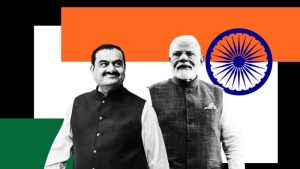How western sanctions are squeezing Russia
Unlock the Editor’s Digest for free
Roula Khalaf, Editor of the FT, selects her favourite stories in this weekly newsletter.
This article is an on-site version of Martin Sandbu’s Free Lunch newsletter. Premium subscribers can sign up here to get the newsletter delivered every Thursday. Standard subscribers can upgrade to Premium here, or explore all FT newsletters
I only got one and a half things right in my otherwise completely mistaken column last week: I said that “I don’t know anything about who will win” the US presidential election (and that I didn’t trust the polls’ message of a dead heat). My prediction that the outgoing administration’s attempt at a Rooseveltian radicalism to address people’s economic grievances would ultimately win the day was wrong; Donald Trump’s victory was emphatic. I recommend the FT’s analysis of the detailed results. When I have had time to go through them in detail, I’ll offer up a thorough postmortem of where my reasoning is most likely to have broken down.
For today, I will focus on policy rather than politics. Specifically, on a policy area that Trump will soon be in a position to change should he choose to: western sanctions on Russia. It’s not a bad time to highlight how those sanctions work, as illustrated through a recent important sign of unhappiness among the country’s business leadership.
No lesser figure than Sergei Chemezov, the chief executive of Russia’s state-controlled weapons producer Rostec, has publicly warned that Russian industrial companies will struggle to export high-tech goods because of high domestic interest rates and the enormous demand for hardware generated by President Vladimir Putin’s war against Ukraine. “If we continue to work like this, most companies will go bankrupt,” Chemezov said.
This tells us something important about war economies, resource constraints and, above all, the success of western sanctions.
War is expensive. Two recent pieces by Alexandra Prokopenko and Agathe Demarais lay bare the costs of Putin’s assault on Ukraine. Military expenses are reaching 40 per cent of public spending, or 8 per cent of GDP, with further public expenditure on undisclosed but no doubt security-related areas, as well as spending that is not categorised as military but deals with the fallout of the war. For example, the government uses public money to selectively offset the pain of more expensive credit by subsidising mortgages and some corporate credit: it seems about 15 per cent of rouble-denominated loans are subsidised.
The key here is to lift our gaze from just the accounting numbers in the budget, important as they are, and focus on how real physical resources need to be diverted from civilian purposes and spending that would raise the welfare of Russians. The central bank has stated that the economy’s productive capacity is coming up against its physical limits.
So, how can an economy that is still exporting more than it is importing — and still accumulating external surpluses of more than $50bn a year — be running up against real resource constraints? This is where sanctions matter. And while the sanctions on what Russia can sell are of course important, what matters most in constraining the government are the sanctions that make it harder for it to acquire resources it doesn’t generate at home. Remember it is imports, not exports, that expand a country’s ability to consume, including consuming resources for war.
Three types of sanctions severely limit Russia’s ability to import and therefore to make use of its export earnings (including those saved up from earlier). First and obviously, actual trade sanctions on dual-use and military goods and some services. Second, and at least as important, are measures making it hard to pay for things it wants from abroad. These include sanctions on Russian financial institutions and measures to exclude them from the technical mechanisms facilitating cross-border payments, such as blocking access to the Swift interbank messaging service and correspondent banking in US dollars. Third is the immobilisation of Russia’s central bank reserves, which both hits the functioning of Russian foreign exchange markets and removes about $300bn of liquid assets from Moscow’s control.
There is no doubt that these measures are having an effect. We see this through the hard work Moscow is putting into trying to set up an alternative payment system. In my column this week, I wrote about how this was a big part of the Brics summit just hosted in Russia and why it is not so easy to accomplish.
We also see it in how Russia is returning to Soviet ways and resorting to barter. My colleagues have a mesmerising report on this practice, leading with a company bartering chickpeas for tangerines. It cites an official at a Moscow-based export-import trade body as saying: “Direct payments are difficult in the current situation, and barter is an excellent alternative.”
In the real world, barter is of course not an adequate substitute for monetised trade. It incurs higher costs to identify the right trade partner to match up with — someone who has use of your product and has a product that’s useful to you — as well as the practical arrangements of the exchange. It costs Russia bargaining power in its commercial relationships, because its companies are forced to use barter while foreign companies have free access to the global monetised trading economy. Finally, by replacing the price mechanism, the spread of barter degrades the informational environment that allows businesses to make profit-maximising choices, as the famous 1945 paper by Friedrich Hayek explained.
To top it off, there is nothing that screams “resource constraints” louder than having to exchange your military technology knowhow for soldiers from a dirt-poor but heavily armed totalitarian dictatorship.
So these sanctions are biting. They impose constraints in terms of real resources, in that it’s hard for Russia to import them from abroad, and in terms of financial decision making, in that they make it hard to fund the budget from fiscal savings accumulated from past budget savings. That leads to two challenges. One is just how to practically mobilise domestic resources: how to redirect the real economy towards causing more suffering and destruction across the border with Ukraine. The other is political: how to move these resources away from their previous uses without upsetting the losers too much.
If you can’t draw on savings abroad or ongoing export sales to ease your budget or resource constraints, the only way to get more resources for your illegal war is to take them away from alternative uses at home. And there are basically three ways in which a government can make such a transfer happen:
-
Through policies that force the private sector to reduce spending or give up resources, ranging from taxation, higher interest rates and outright confiscation (or conscription, in the sense of “human resources”)
-
Through domestic borrowing (foreign borrowing is hampered by sanctions), where it cajoles the domestic private sector into giving up resources against a promise to get them back with interest later
-
Through inflation that reduces the real economic value of assets and incomes that are not fully protected against price rises
The choice will be determined by a trade-off between having to raise enough resources and imposing little enough pain on those who might be able to oppose you. That, as all revolutions (and perhaps even this week’s US election) seem to tell us, requires avoiding excessive inflation. Inflation is not low in Russia: prices are rising at an annual rate of 9 per cent a year, and wages by a lot more in the sectors trying to draw in labour. But it would have been much higher had it not been for a draconian monetary policy, with the central bank rate at 21 per cent.
Which is where we come full circle, back to Chemezov’s complaint about the high cost of credit. Only on the surface is this a discussion about the right monetary policy. At heart, it reflects an acute resource allocation dilemma. The high interest rate is part of a necessary policy package that starves long-term corporate investment and all but some subsidised credit-financed spending in order to maximise resources in short-term defence-related production while avoiding too much of the burden being paid by the real wealth inflation-exposed households. If exporters’ corporate investment was not to suffer as much, somebody else would have to suffer instead. But we have come to the point where executives very much part of the establishment feel free to complain about the resource allocation that has been decided.
The upshot is that western policy is having significant economic and political effects, despite superficially positive accounting numbers for Russian GDP growth. These are levers western countries can work harder at little or no cost to themselves: by cutting off more Russian financial institutions, by wielding secondary sanctions (more) to discourage circumvention, by redirecting outright Moscow’s blocked central bank reserves for Ukraine’s benefit, and by speeding up the technological upgrading of the west’s cross-border financial architecture to pre-empt leapfrogging by Russia and its friends.
These are the tools of a world power. Someone should tell president-elect Trump about them.
Other readables
Recommended newsletters for you
Chris Giles on Central Banks — Your essential guide to money, interest rates, inflation and what central banks are thinking. Sign up here
Unhedged — Robert Armstrong dissects the most important market trends and discusses how Wall Street’s best minds respond to them. Sign up here
#western #sanctions #squeezing #Russia




